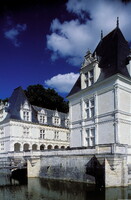| dc.coverage.spatial | Site: Villandry, Centre, France | en_US |
| dc.coverage.temporal | ca. 1525 (creation) | en_US |
| dc.creator | unknown (French) | en_US |
| dc.date | 1525 | en_US |
| dc.date.accessioned | 2013-02-22T15:45:18Z | |
| dc.date.available | 2013-02-22T15:45:18Z | |
| dc.date.issued | 1525 | en_US |
| dc.identifier | 193963 | en_US |
| dc.identifier.other | archrefid: 1420 | en_US |
| dc.identifier.uri | http://hdl.handle.net/1721.3/101297 | |
| dc.description | Lateral view of north elevations of pavilions showing moat; The chateau is one of the last great Renaissance houses to be built on the Loire, and as such displays a Classical elegance reflecting Italian influence. It possesses features which are unusual in Touraine, such as rectangular pavilions (in place of the former round towers) in addition to the layout of the esplanade and its moat. It was originally a fortress, but nothing remains of that settlement except the keep, a square tower incorporated in the present structure. Acquired in the early 1500's by Jean Le Breton, France's Controller-General for War under King Francois I, a new château was constructed around the original 14th-century keep where King Philip II of France once met Richard I of England ("the Lionhearted") to discuss peace. The château remained in the Le Breton family for more than two centuries until it was acquired by the Marquis de Castellane. During the French Revolution the property was confiscated and in the early 1800's Emperor Napoleon acquired it for his brother Joseph Bonaparte. Source: Wikipedia; http://en.wikipedia.org/wiki/Main_Page (accessed 7/16/2008) | en_US |
| dc.format.medium | stone | en_US |
| dc.rights | © Scott Gilchrist, Archivision, Inc. | en_US |
| dc.subject | architectural exteriors | en_US |
| dc.subject | rulers and leaders | en_US |
| dc.subject | Renaissance | en_US |
| dc.title | Château de Villandry | en_US |
| dc.type | image | en_US |
| dc.rights.access | Licensed for educational and research use by the MIT community only | en_US |
| dc.identifier.vendorcode | 1A2-F-CV-1-A6 | en_US |
| vra.culturalContext | French | en_US |
| vra.technique | construction (assembling) | en_US |
| vra.worktype | château | en_US |
| dc.contributor.display | unknown (French) | en_US |


